Related Research Articles

The Messerschmitt Me 262, nicknamed Schwalbe in fighter versions, or Sturmvogel in fighter-bomber versions, is a fighter aircraft and fighter-bomber that was designed and produced by the German aircraft manufacturer Messerschmitt. It was the world's first operational jet-powered fighter aircraft.

The Gloster Meteor was the first British jet fighter and the Allies' only jet aircraft to engage in combat operations during the Second World War. The Meteor's development was heavily reliant on its ground-breaking turbojet engines, pioneered by Frank Whittle and his company, Power Jets Ltd. Development of the aircraft began in 1940, although work on the engines had been under way since 1936. The Meteor first flew in 1943 and commenced operations on 27 July 1944 with No. 616 Squadron RAF. The Meteor was not a sophisticated aircraft in its aerodynamics, but proved to be a successful combat fighter. Gloster's 1946 civil Meteor F.4 demonstrator G-AIDC was the first civilian-registered jet aircraft in the world. Several major variants of the Meteor incorporated technological advances during the 1940s and 1950s. Thousands of Meteors were built to fly with the RAF and other air forces and remained in use for several decades.

The Henschel Hs 132 was a World War II dive bomber and interceptor aircraft of the German Luftwaffe that never saw service. The unorthodox design featured a top-mounted BMW 003 jet engine and the pilot in a prone position. The Soviet Army occupied the factory just as the Hs 132 V1 was nearing flight testing, the V2 and V3 being 80% and 75% completed.

The Me 209 of 1943 was an attempt to create an enhanced version of the Bf 109, which served as the Luftwaffe's primary fighter aircraft throughout World War II. The Me 209, despite its designation, bore no relationship to the earlier Me 209.
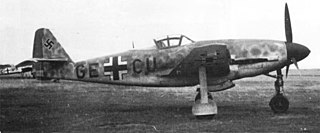
The Messerschmitt Me 309 was a prototype German fighter, designed in the early years of World War II to replace the Bf 109. Although it had many advanced features, the Me 309's performance left much to be desired and it had so many problems that the project was cancelled with only four prototypes built. The Me 309 was one of two failed Messerschmitt projects intended to replace the aging Bf 109, the other being the Me 209 of 1943.
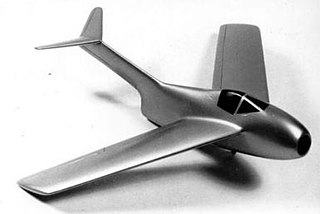
The Focke-Wulf Ta 183 Huckebein was a design for a jet-powered fighter aircraft intended as the successor to the Messerschmitt Me 262 and other day fighters in Luftwaffe service during World War II. It had been developed only to the extent of wind tunnel models when the war ended, but the basic design was further developed postwar in Argentina as the FMA IAe 33 Pulqui II. The name Huckebein is a reference to a trouble-making raven from an illustrated story in 1867 by Wilhelm Busch.
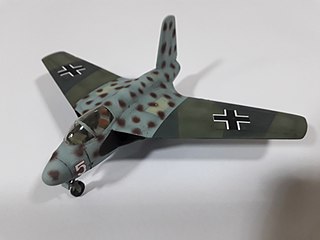
The Lippisch P.15 was a proposed World War II German fighter aircraft.

The Messerschmitt P.1101 was a single-seat, single-jet fighter project of World War II, developed as part of the 15 July 1944 Emergency Fighter Program which sought a second generation of jet fighters for the Third Reich. A prominent feature of the P.1101 prototype was that the sweep angle of the wings could be changed before flight, a feature further developed in later variable-sweep aircraft such as the Bell X-5 and Grumman XF10F Jaguar.

The Messerschmitt P.1112 was a proposed German jet fighter, developed by Messerschmitt AG during the closing stages of World War II, and intended for use by the Luftwaffe. The progress of the war prevented the completion of a prototype before the fall of Nazi Germany. Its design, however, had a direct influence on postwar US Navy carrier fighters.

Due to the Messerschmitt Bf 109's versatility and time in service with the German and foreign air forces, numerous variants were produced in Germany to serve for over eight years with the Luftwaffe. Additional variants were produced abroad totalling in 34,852 Bf 109s built.

The Arado E.381 was a proposed parasite fighter aircraft. Conceived by Arado Flugzeugwerke in December 1944 for Germany's Luftwaffe during World War II, the E.381 was to have been carried aloft by and launched from an Arado Ar 234 "mother" aircraft. It would then have activated its rocket engine, which would have propelled it to attack Allied bombers. Development was cancelled due to lack of funds and official support.
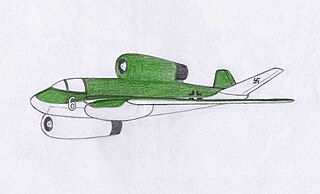
The Heinkel P.1073, known also as Strahljäger, was a fighter project developed for the Luftwaffe by Heinkel aircraft manufacturing company during the last years of World War II.

The Messerschmitt P.1110 was a design for a single-seat, high-altitude interceptor, prepared for the German Luftwaffe by the Messerschmitt aircraft manufacturing company, under the Emergency Fighter Program during the last months of World War II.

The Messerschmitt P.1099 was a two-seat prototype jet plane designed by Messerschmitt for the Luftwaffe before the end of the Second World War.

The Focke-Wulf Volksjäger, meaning "People's Fighter" in German, was a German emergency fighter project for the Luftwaffe. It was designed by Focke-Wulf industries towards the end of World War II as part of the defense effort against the devastating Allied bombing raids.
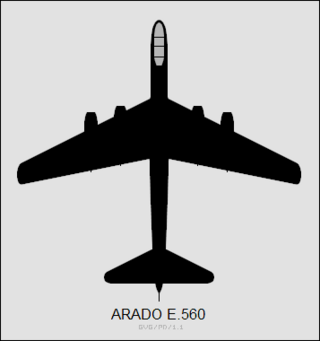
The Arado E.560 was a multi-engined Arado medium-range jet tactical bomber proposed during the Second World War.
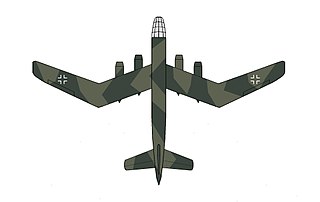
The Blohm & Voss Bv P 188 was a long-range, heavy jet bomber design project by the Blohm & Voss aircraft manufacturing division during the last years of the Third Reich. It featured a novel W-wing planform with variable incidence.

The Gotha Go P.60 was a jet-powered flying wing fighter proposed during World War II by Gothaer Waggonfabrik (Gotha). It was conceived as an improved derivative of the single-seat Horten Ho 229, which Gotha had begun to manufacture as the Go 229. The initial concept a two-seat multi-role fighter that was subsequently developed into a three-seat night and all-weather fighter, but no variant was ever built.
The Messerschmitt P.1107 was a jet-powered bomber project developed in the final years of the Second World War.

The Messerschmitt Me 262 was a German World War II fighter aircraft built by Messerschmitt in the later stages of the war, and under license by Avia post-war.
References
- 1 2 Lepage, Jean-Denis G. G. (2009). Aircraft of the Luftwaffe, 1935-1945: an illustrated guide. McFarland. p. 272. ISBN 978-0-7864-3937-9.